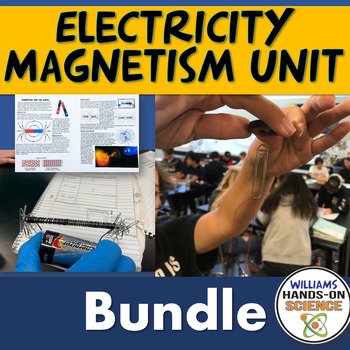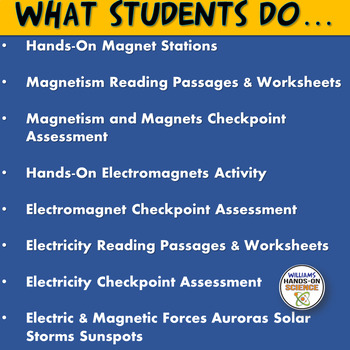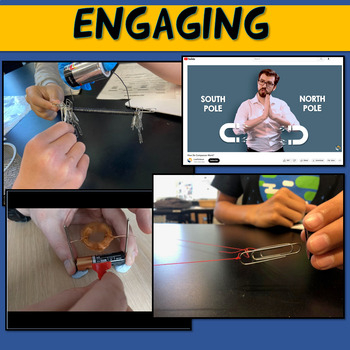Electricity Magnetism Unit Bundle NGSS MS PS2 3 MS PS2 5
- Google Drive™ folder

What educators are saying
Products in this Bundle (5)
Bonus
Description
This 2-3 week, hands-on, engaging and easy to deliver unit is so fun to teach! Save time and money and let me plan your electricity and magnetism unit for you! If you are teaching the NGSS disciplinary core idea PS2.B: Types of Interactions (electricity and magnetism), this resource is perfect for you!
Your students will be blown away at how fun and interesting magnets and electricity can be! This bundle is engaging, rigorous and easy prep! The materials are inexpensive, and my teacher notes will make classroom management easy so that you have a classroom full of engaged and on-task students!
Students do the following:
- Hands-On Magnet Stations
- Magnetism Reading Passages & Worksheets
- Magnetism and Magnets Checkpoint Assessment
- Hands-On Electromagnets Activity
- Electromagnet Checkpoint Assessment
- Electricity Reading Passages & Worksheets
- Electricity Checkpoint Assessment
- Electric & Magnetic Forces Auroras Solar Storms Sunspots
This resource comes with the following:
· Easy to use scope & sequence with links to every Google and hard copy
· Magnet Stations hands-on activity with google and hard copies
· Electromagnet hands-on activity with google and hard copies
· Magnetism Reading Passages and Worksheets, both google and hard copies
· Electricity Reading Passages and Worksheets, both google and hard copies
· 3 Google Form Checkpoint Assessments
· Electric & Magnetic Forces Auroras Solar Storms Sunspots Lesson
· Keys
· Detailed Teacher Notes
This resource has the following concepts:
· Electricity & Magnetism
· Positive and Negative Charges
· Repulsion and Attraction of Magnetic Forces
· Magnetic Fields
· Factors that Affect Strength of Magnetic Fields
· Domains
· North and South Poles
· Repulsion and Attraction of Electrical Charges
· Electrical Fields
· Factors that Affect Strength of Electrical Fields
· Non-contact forces
· Electric Current
· Electric Charge
· Magnetosphere
· Magnetic Poles
· Sun Spot
· Solar Flare
· Solar Wind
· Magnetically Charged Particles
· North and South Poles
· Aurora or Northern Lights
This resource has the following NGSS Standards:
NGSS Performance Expectations
MS-PS2-3. Ask questions about data to determine the factors that affect the strength of electric and magnetic forces.
MS-PS2-5. Conduct an investigation that provides evidence that fields exist between objects exerting forces on each other even though the objects are not in contact.
NGSS Disciplinary Core Ideas (DCI)
PS2.B: Types of Interactions
• Electric and magnetic (electromagnetic) forces can be attractive or repulsive, and their sizes depend on the magnitudes of the charges, currents, or magnetic strengths involved and on the distances between the interacting objects. (MS-PS2-3)
• Forces that act at a distance (electric, magnetic, and gravitational) can be explained by fields that extend through space and can be mapped by their effect on a test object (a charged object, or a ball, respectively). (MS-PS2-5)
NGSS Science and Engineering Practices (SEP)
Asking questions and defining problems in grades 6–8 builds from grades K–5 experiences and progresses to specifying relationships between variables, and clarifying arguments and models.
Ask questions that can be investigated within the scope of the classroom, outdoor environment, and museums and other public facilities with available resources and, when appropriate, frame a hypothesis based on observations and scientific principles. (MS-PS2-3)
Develop and use a model to describe phenomena. (MS-ESS1-1) (MS-ESS1-2)
NGSS Cross Cutting Concepts (CCC)
Cause and Effect
Cause and effect relationships may be used to predict phenomena in natural or designed systems. (MS-PS2-3),(MS-PS2-5)
Systems and System Models
Models can be used to represent systems and their interactions—such as inputs, processes and outputs—and energy, and matter flows within systems. (MS-PS2-1),(MS-PS2-4),
Stability and Change
Explanations of stability and change in natural or designed systems can be constructed by examining the changes over time and forces at different scales. (MS-PS2-2)
⭐ Bill Nye Questions Waves Electromagnetic Spectrum
⭐ Claim Evidence Reasoning (CER): Autumn Equinox Can Fall on Different Days
⭐ ESS1.A & B PS4.A & B ESS2.A NGSS Integrated Scale of Universe Card Sort & Video
⭐ ESS1.A MS-ESS1-2 The Universe & Its Stars Astronomy Activity Scale Space Systems
⭐ ESS3.C NGSS Claim Evidence Reasoning: Climate Change is Bad for Humans
⭐ Earth, Moon and Sun PowerPoint and Guided Notes
⭐ MS-ESS1-1: Oreo Moon Phases Lab NGSS Modeling
⭐ MS-PS1-5: Chemical Reactions Simulation Conservation of Mass Close Reading Notes
⭐ MS-PS4-1 MS-PS4-2 MS-PS4-3 Waves Card Sort, Vocabulary Chart and YouTube Clips
⭐ MS-PS4-3: NGSS Analog Vs. Digital Wave Properties 5E Telephone Lab
⭐ NGSS Astronomy Resource Bundle: PowerPoint Labs Guided Notes Prezi Board Game
⭐ NGSS Analog Digital Card Sort PS4.C Information Technologies & Instrumentation
⭐ NGSS Black Holes & Galaxies Claim Evidence Reasoning Graphic Organizer
⭐ NGSS Claim Evidence Reasoning (CER) Big Bang Graphic Organizer
⭐ NGSS Claim Evidence Reasoning (CER) High Frequency Sound Waves
⭐ NGSS Claim Evidence Reasoning (CER) Water Found on Mars
⭐ NGSS Claim Evidence Reasoning The Mysterious Planet Nine Solar System Astronomy
⭐ NGSS Earth's Orbit Around The Sun Stop Motion Movie
⭐ NGSS Electromagnetic Spectrum Waves Doodle Notes & PowerPoint
⭐ NGSS Expanding Universe Claim Evidence Reasoning Graphic Organizer
⭐ NGSS MS-ESS1-2 MS-ESS1-2 Evidence for Big Bang Theory Online CER Activity
⭐ NGSS Middle School Sound Waves Stations & Close Reading
⭐ NGSS PowerPoint Sound, Light, Digital, Analog, Transverse and Longitudinal Waves
⭐ NGSS Waves Electromagnetic Spectrum Properties Worksheet
⭐ NGSS Waves Light Stations Electromagnetic Phenomena
⭐ NGSS Waves Properties & Electromagnetic Spectrum Growing Resource Bundle
⭐ NGSS Waves Properties Doodle Notes Electromagnetic Spectrum PowerPoint Science
⭐ NGSS Waves: Transverse Vs. Longitudinal Lab Close Reading Editable PowerPoint
⭐ NGSS: MS-PS2-2 MS-PS2-4 Gravity & Mass 5e Planning & Carrying Out Investigation
⭐ The Human Sundial
⭐ The Planets Board Game
⭐ The Sun Board Game
TERMS OF USE
• All rights reserved by Williams Hands On Science, Inc.
• This product is to be used by the original purchaser only.
• Intended for classroom and personal use only.
• Copying for more than one teacher, classroom, department, school, or school system is prohibited.
• This product may not be distributed or displayed digitally for public view.
• Failure to comply is a copyright infringement and a violation of the Digital Millennium Copyright Act (DMCA).
If there are any errors or questions, please contact me through TpT or email me at:
williamshandsonscience@gmail.com
Thank you for taking a look!
Please follow me on TpT for new products and check me out on Instagram for my products in action!
https://www.instagram.com/williams_hands_on_science/





